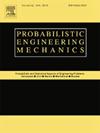A two stage Kriging approach for Bayesian optimal experimental design
IF 3
3区 工程技术
Q2 ENGINEERING, MECHANICAL
引用次数: 0
Abstract
This paper presents a two-stage Kriging framework designed to efficiently tackle Bayesian optimal experiment design (OED) problems. To enhance computational efficiency in evaluating the Shannon expected information gain (SEIG), we introduced a Kriging surrogate as a replacement for the original forward model (stage 1 Kriging). This surrogate is utilized within the Double Loop Monte Carlo method for SEIG estimation. We employed the Efficient Global Optimization (EGO) framework as the optimizer, which requires the construction of a Kriging surrogate of the SEIG (stage 2 Kriging). Within EGO, the expected improvement infill criterion was employed as the active learning metric. The underlying rationale of employing a two-stage Kriging approach is to alleviate the curse of dimensionality typically associated with Kriging surrogates. In this strategy, the first stage of Kriging is focused on surrogating the random parameter space, while the second stage is dedicated to modeling the design variable space. By adopting this two-stage approach, the need for constructing a global surrogate for the forward model in both spaces is circumvented. This segmentation allows for more efficient and accurate surrogate modeling, particularly in high-dimensional spaces, enhancing the overall computational performance of the optimization process. The method was applied to three OED problems. The results demonstrate that the proposed two-stage Kriging approach (EGO-KR) effectively addressed the analyzed problems, offering good precision and significant computational savings, particularly in the third and more complex example.
求助全文
约1分钟内获得全文
求助全文
来源期刊

Probabilistic Engineering Mechanics
工程技术-工程:机械
CiteScore
3.80
自引率
15.40%
发文量
98
审稿时长
13.5 months
期刊介绍:
This journal provides a forum for scholarly work dealing primarily with probabilistic and statistical approaches to contemporary solid/structural and fluid mechanics problems encountered in diverse technical disciplines such as aerospace, civil, marine, mechanical, and nuclear engineering. The journal aims to maintain a healthy balance between general solution techniques and problem-specific results, encouraging a fruitful exchange of ideas among disparate engineering specialities.
 求助内容:
求助内容: 应助结果提醒方式:
应助结果提醒方式:


